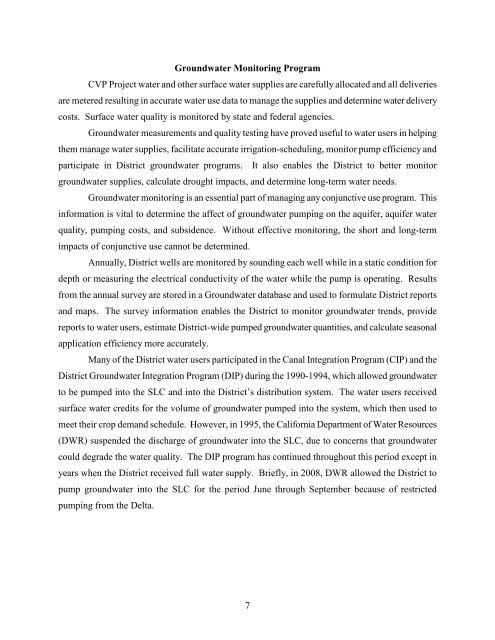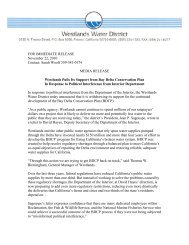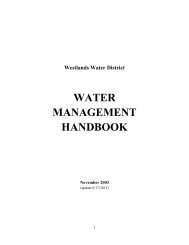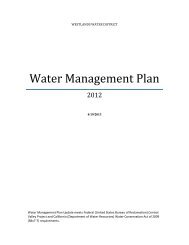Deep Groundwater Conditions Report - Westlands Water District
Deep Groundwater Conditions Report - Westlands Water District
Deep Groundwater Conditions Report - Westlands Water District
Create successful ePaper yourself
Turn your PDF publications into a flip-book with our unique Google optimized e-Paper software.
<strong>Groundwater</strong> Monitoring ProgramCVP Project water and other surface water supplies are carefully allocated and all deliveriesare metered resulting in accurate water use data to manage the supplies and determine water deliverycosts. Surface water quality is monitored by state and federal agencies.<strong>Groundwater</strong> measurements and quality testing have proved useful to water users in helpingthem manage water supplies, facilitate accurate irrigation-scheduling, monitor pump efficiency andparticipate in <strong>District</strong> groundwater programs. It also enables the <strong>District</strong> to better monitorgroundwater supplies, calculate drought impacts, and determine long-term water needs.<strong>Groundwater</strong> monitoring is an essential part of managing any conjunctive use program. Thisinformation is vital to determine the affect of groundwater pumping on the aquifer, aquifer waterquality, pumping costs, and subsidence. Without effective monitoring, the short and long-termimpacts of conjunctive use cannot be determined.Annually, <strong>District</strong> wells are monitored by sounding each well while in a static condition fordepth or measuring the electrical conductivity of the water while the pump is operating. Resultsfrom the annual survey are stored in a <strong>Groundwater</strong> database and used to formulate <strong>District</strong> reportsand maps. The survey information enables the <strong>District</strong> to monitor groundwater trends, providereports to water users, estimate <strong>District</strong>-wide pumped groundwater quantities, and calculate seasonalapplication efficiency more accurately.Many of the <strong>District</strong> water users participated in the Canal Integration Program (CIP) and the<strong>District</strong> <strong>Groundwater</strong> Integration Program (DIP) during the 1990-1994, which allowed groundwaterto be pumped into the SLC and into the <strong>District</strong>’s distribution system. The water users receivedsurface water credits for the volume of groundwater pumped into the system, which then used tomeet their crop demand schedule. However, in 1995, the California Department of <strong>Water</strong> Resources(DWR) suspended the discharge of groundwater into the SLC, due to concerns that groundwatercould degrade the water quality. The DIP program has continued throughout this period except inyears when the <strong>District</strong> received full water supply. Briefly, in 2008, DWR allowed the <strong>District</strong> topump groundwater into the SLC for the period June through September because of restrictedpumping from the Delta.7





